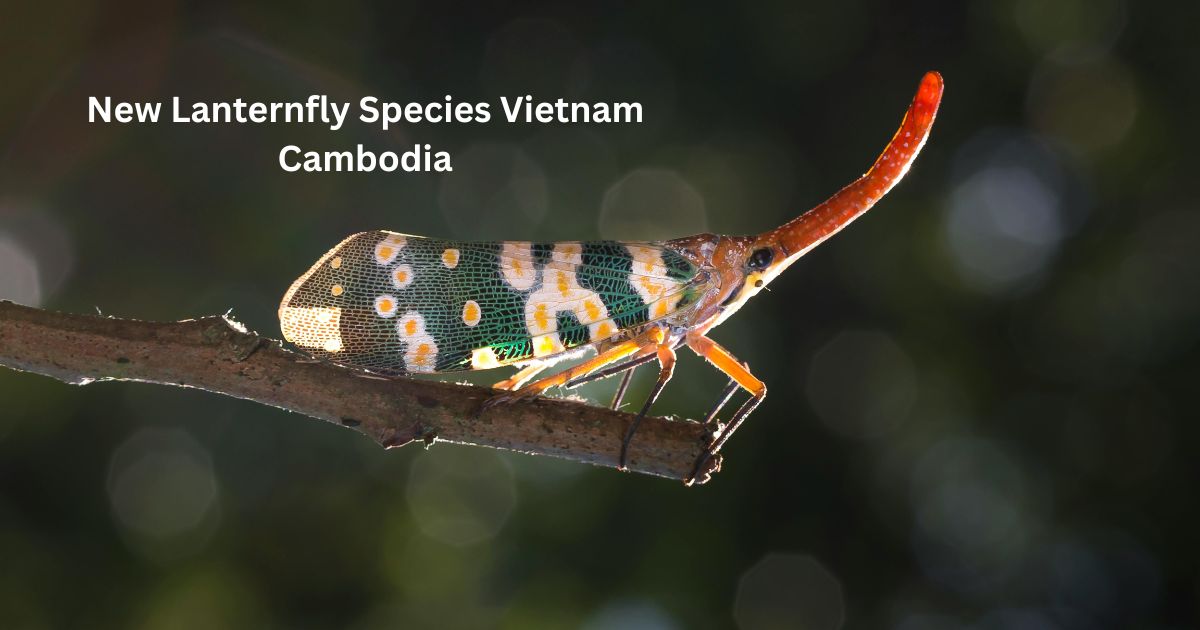The discovery of a new lanternfly species in Vietnam Cambodia has ignited interest among entomologists and environmental scientists. Lanternflies are known for their distinct appearance and destructive tendencies, as they often damage crops and trees. This article delves into the significance of this new species, its potential ecological impact, and what it means for the region’s ecosystems and agriculture.
What is a Lanternfly and Why is It Important?
Lanternflies belong to the Fulgoridae family and are distinguished by their striking appearance, featuring a large, lantern-like structure on their heads. These insects are primarily known for their destructive feeding habits. Lanternflies suck sap from plants, which weakens the plants and makes them more susceptible to diseases. Some species, including the newly discovered lanternfly in Vietnam Cambodia, are known to cause significant harm to crops and forest ecosystems.
Despite their eye-catching looks, lanternflies are considered pests, particularly in regions where they are not native. Their potential to devastate both agricultural and natural ecosystems is one of the main reasons researchers are keeping a close eye on their spread.
The Discovery of the New Lanternfly Species in Vietnam Cambodia
The new lanternfly species found in Vietnam Cambodia marks an exciting breakthrough in the study of these pests. Scientists from both local and international teams identified the new species while conducting fieldwork in the rural areas of these two countries. Their research has highlighted the unique features of this species, distinguishing it from other known lanternflies.
This discovery not only adds to the growing body of knowledge about lanternflies but also presents an opportunity to study how these insects adapt to different environments. The new lanternfly species was found in a remote part of Southeast Asia, an area that has seen limited exploration in recent years. This suggests that there are likely more undiscovered species in the region, emphasizing the need for continued research.
The Ecological Role of Lanternflies
Lanternflies play a dual role in the ecosystems they inhabit. On one hand, they are herbivores, feeding on the sap of various plants. While this may seem harmless, their feeding behavior can lead to weakening of plants, making them more vulnerable to secondary infections. Furthermore, lanternflies also produce honeydew, a sugary secretion that attracts other insects and can foster the growth of mold on plants.
However, lanternflies are not solely destructive. In the ecosystems of Vietnam and Cambodia, they may also act as food for local predators, contributing to the food web. Still, the new lanternfly species in Vietnam Cambodia poses a potential risk if it spreads to more regions. Its ability to damage plants and affect local biodiversity must be closely monitored.
Agricultural Risks Posed by the New Lanternfly Species
Vietnam and Cambodia rely heavily on agriculture, with crops such as rice, rubber, and fruit being staples in the region. The introduction of a new lanternfly species could spell trouble for farmers, especially if the species spreads to agricultural areas. Lanternflies feed on the sap of many types of plants, and their presence could affect crop yields, costing farmers significant losses.
In addition, lanternflies are known to transmit plant diseases, further exacerbating their impact on agriculture. For example, they are vectors for the spread of the invasive fungus Fusarium species, which can severely damage crops. With the discovery of a new lanternfly species, farmers in the region must be proactive in managing the risk of infestation.
How Scientists Identified the New Lanternfly Species
The identification of the new lanternfly species in Vietnam Cambodia came about through a combination of field research and laboratory analysis. Entomologists working in these countries collected samples from different parts of the region, taking note of any lanternflies that appeared to differ from known species. Once specimens were collected, scientists used genetic analysis to compare the DNA of these new lanternflies to that of other species, confirming that they represented a previously unidentified species.
Morphological characteristics, such as body size, color patterns, and wing shape, also played a key role in distinguishing this species. This discovery highlights the importance of continued field studies in remote areas, as they offer valuable insights into the biodiversity of ecosystems that may otherwise go unnoticed.
The Geography of Vietnam and Cambodia: Ideal Conditions for Lanternflies
Vietnam and Cambodia have warm, tropical climates that provide ideal conditions for the survival and spread of lanternflies. These insects thrive in environments with abundant plant life, where they can feed on a variety of tree and plant species. The dense forests and rich agricultural lands in both countries offer the perfect habitat for lanternflies to reproduce and establish colonies.
The warm temperatures and seasonal rainfall in Vietnam and Cambodia ensure a steady supply of food sources for lanternflies. These environmental factors make the region particularly vulnerable to the spread of the newly discovered species. However, they also present an opportunity for researchers to study how lanternflies adapt to different ecological niches.
Invasive Potential of the New Lanternfly Species
One of the main concerns surrounding the discovery of the new lanternfly species in Vietnam Cambodia is its potential to become an invasive pest. Lanternflies are notorious for their ability to spread rapidly and colonize new areas. Given the region’s favorable climate and abundant plant life, it is possible that the new species could migrate to other parts of Southeast Asia or even further afield.
Invasive species can cause significant disruptions to local ecosystems, outcompeting native species for resources and altering the structure of plant communities. The spread of the new lanternfly species could lead to such disruptions, affecting both natural environments and agricultural production. Therefore, it is crucial for scientists and policymakers to monitor the species’ movement closely.
Efforts to Control Lanternfly Populations
Efforts to control lanternfly populations are already underway in regions where lanternflies are known to be a problem. In Vietnam and Cambodia, scientists are working with local authorities to develop strategies to manage the spread of the new lanternfly species. These measures may include the use of natural predators, pesticides, and public awareness campaigns to encourage early detection and rapid response to outbreaks.
In addition, researchers are investigating biological control methods, such as introducing parasitoids that target lanternfly eggs or larvae, to help manage the population of these pests. Ongoing research and collaboration between local governments and scientific institutions are essential in preventing the spread of this new lanternfly species.
Conslusion
Local communities in Vietnam and Cambodia have an important role to play in preventing the spread of the new lanternfly species. Farmers, gardeners, and tourists are encouraged to report any sightings of the insect to local authorities, helping to track its movement and take action when necessary. Public education campaigns are also vital to raise awareness about the importance of detecting and controlling lanternfly populations.
By working together, local communities can help prevent the new lanternfly species from spreading to other areas, safeguarding both local ecosystems and agricultural industries. Community involvement is key to the success of any pest management program.
FAQs
What makes the new lanternfly species in Vietnam Cambodia unique?
The new lanternfly species discovered in Vietnam Cambodia is unique due to its distinct physical features and genetic makeup. Scientists identified it through field research and genetic analysis, confirming that it differed from other known lanternfly species in the region.
How can lanternfly infestations impact agriculture in Southeast Asia?
Lanternfly infestations can severely damage crops by feeding on plant sap, weakening the plants and making them more susceptible to diseases. This can result in significant crop loss, which impacts the economy of Southeast Asia, where agriculture plays a vital role.
What efforts are being made to control the new lanternfly species?
Efforts include monitoring lanternfly populations, using biological control methods like parasitoids, and raising public awareness. Governments and local institutions are working together to develop strategies to prevent the spread of this new species.
Why is it important to study the behavior of lanternflies?
Studying lanternflies helps scientists understand their impact on ecosystems and agriculture. Understanding their behavior and life cycle can inform strategies to prevent infestations and mitigate their effects on crops and native plants.
How can local communities help prevent the spread of lanternflies?
Local communities can help by reporting sightings of lanternflies, participating in public awareness campaigns, and adopting best practices for pest control. Collaboration between residents, farmers, and government agencies is crucial in managing the spread of the new lanternfly species.



